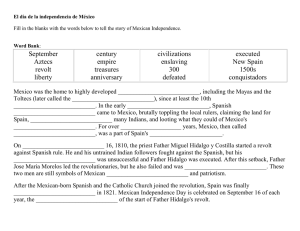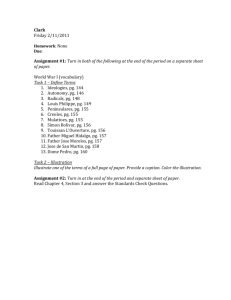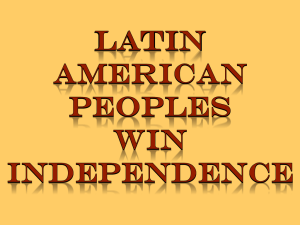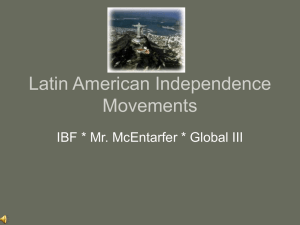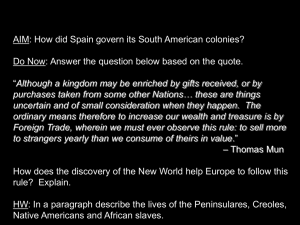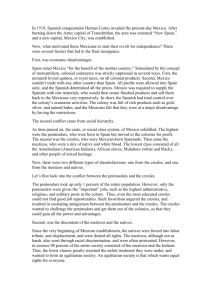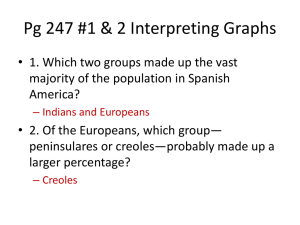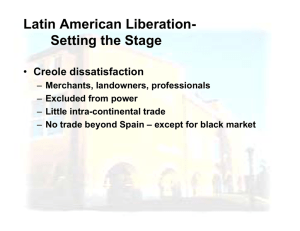Click
advertisement
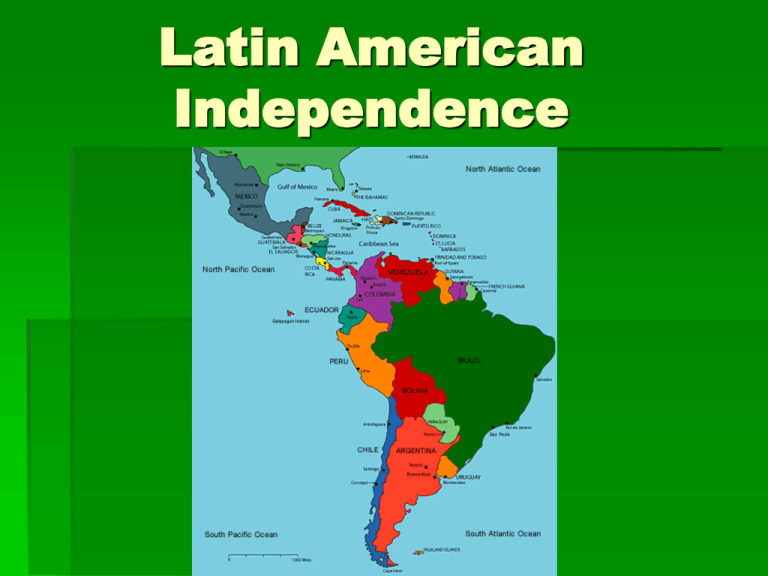
Latin American Independence Colonial Society Divided Six classes of people existed in Latin America society: Peninsulares – born in Spain (at the top) Creoles – Spaniards born in Latin America Mestizos – Mixed European / Indian ancestry Mulattos – Mixed European / African ancestry Africans Indians (at the bottom) Mestizo: Spanish/Indian Your Turn! Discuss… How is this division of social classes and hierarchy similar to that in the Old Regime in France? How was it different? Revolutions in the Americas Where in Latin America was independence first declared? (open books to p. 251) Early 1800s: French colony of Saint Domingue was the first Latin American colony to fight for independence. Almost all of the people who lived in the French colony were slaves of African origin In 1791, about 100,000 of them rose in revolt. Toussaint L’Ouverture, a former slave, was their leader. Toussaint L’Ouverture In 1802 Napoleon sent troops to the island to end the rebellion but FAILED!! In 1804, the colony declared its independence as Haiti (Which means “mountainous land” to Arawak natives). This was the first black colony to free itself from European control (inspired colonies in Africa to later become free…). Your Turn! Discuss… What Enlightenment ideas was this revolution referencing? Creoles Lead Independence Why did Creoles want independence? Creoles felt that they were not treated fairly. Feeling got stronger when Napoleon overthrew the king of Spain and named his own brother as king. Creoles in Latin America had no loyalty to the new king. REVOLT!!! Even after the old king was restored, they did not give up their fight for freedom. Your Turn! Discuss… What other Revolution in the world started when people felt disconnected from their colonizers? What was the major issue there? Creoles Lead Independence Two leaders push much of South America to independence: Simon Bolivar Jose de San Martin Simón Writer Fighter Political thinker Survived defeats and exile to help win independence for Venezuela in 1821. Bolívar José de San Martín Helped win independence for Argentina in 1816 and Chile in 1818. Led Argentinean AND Chilean armies to gain independence for ALL Spanish colonies. Miguel Hidalgo In 1807, French forces occupied Spain and imprisoned King Ferdinand VII. Confusion spread in Mexico. Some creoles plotted to seize the colony's government. One of these men was Miguel Hidalgo y Costilla, a priest. Late on the night of Sept. 15, 1810, he called Indians and mestizos to his church in the town of Dolores. He made a speech known as the Grito de Dolores (Cry of Dolores), in which he called for a rebellion so that Mexicans could govern Mexico. Today, late on September 15, Mexico's president rings a bell and repeats the Grito de Dolores. Mexicans celebrate September 16 as Independence Day. Hidalgo's untrained followers armed themselves and attacked Spanish officials and those who supported the Spaniards. At first, Hidalgo gained support for his cause. But most of his followers were Indians and mestizos, and not creoles. Some Indian communities also refused to support Hidalgo because of the violent ways of the rebels. Hidalgo was forced to retreat. In 1811, Spanish troops captured and executed him Mexico Ends Spanish Rule How did Mexico achieve independence? In Mexico: Mestizos and Indians lead the fight 1810: Miguel Hidalgo, a village priest, called for a revolt against Spanish rule. Creoles united with Spanish government to put down this revolt by the lower classes. Hidalgo lost Jose Maria Morelos took over leadership of the rebels. Jose Maria Morelos y Pavon, another priest, continued Hidalgo's struggle. In 1813, Morelos held a Congress that issued the first formal call for independence. The Congress wrote a constitution for a Mexican republic. Morelos hoped to attract the creoles who wanted reform. He succeeded further than Hidalgo. In 1815, however, Morelos too was captured and executed by the Spaniards. By 1816, Spanish troops had captured or killed almost all of the rebels. Mexico was again at peace, and King Ferdinand VII had returned to the Spanish throne. But the king did not realize that most creoles supported him, and that they still only wanted reform. Instead, the king thought that all Mexicans were traitors to Spain. Ferdinand taxed the creoles and organized a large army to put down any revolutionary movement. His actions convinced many creoles that they no longer could trust Spain. In 1820, a revolt by liberals swept Spain. Ferdinand's power weakened, and many creoles saw their chance for revolution. Liberal and Conservative creoles joined sides. Only a small part of the Spanish forces in Mexico remained loyal to Spain. Mexico Ends Spanish Rule • By the end of 1821, the last Spanish officials withdrew from Mexico, and Mexico became independent. Creoles joined other groups fighting for independence. 1823: Central America separated itself from Mexico. Your Turn! Discuss… Which classes of people revolted and wanted to change the government? Where have we seen this before? Why? Brazil’s Royal Liberator Prince Pedro I Brazil’s Royal Liberator In Brazil, 8,000 creoles signed a paper asking the son of Portugal’s king to rule an independent Brazil. He agreed! Brazil became free in 1822 through a BLOODLESS revolt.
